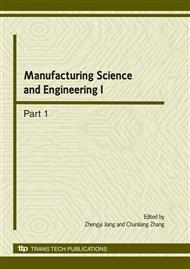p.4124
p.4128
p.4132
p.4135
p.4141
p.4146
p.4150
p.4154
p.4160
The Function of Magnetic Field in a Magnetic-Electrochemical Compound Polishing
Abstract:
Traditionally, the magnetic field is always vertical to the electrical field in a magnetic-electrochemical compound polishing.The magnetic field is set to parallel the electrical field in this paper. The mathematical model of the charged particles movement in a magnetic field is established through the analysis of its movement process when using Coulomb laws and Lorentz force. Through constructing the velocity formulation and loci formulation, the function of the magnetic field is proved. Because of the magnetic field, the concentration polarization of electrochemical reaction can be reduced more and the electrochemical reaction can be accelerated easily than the traditional polishing in which the magnetic field is vertical to the electrical field. Finally, to verify the model, the magnetic-electrochemical compound polishing process has been tested and the results, compared with those obtained from the model, have shown the movement model is reasonable and the analysis to function of magnetic field is correct.
Info:
Periodical:
Pages:
4141-4145
Citation:
Online since:
March 2010
Authors:
Price:
Сopyright:
© 2010 Trans Tech Publications Ltd. All Rights Reserved
Share:
Citation:


